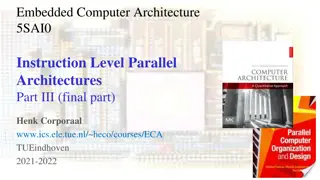Understanding Instruction Formats in Computer Architecture
Explore different types of instruction formats in computer architecture, including one-address, two-address, and zero-address instructions. Learn how instructions are structured and executed, such as specifying operands and memory addresses. Dive into examples like evaluating expressions and organizing data manipulation with various addressing schemes.
Download Presentation

Please find below an Image/Link to download the presentation.
The content on the website is provided AS IS for your information and personal use only. It may not be sold, licensed, or shared on other websites without obtaining consent from the author. Download presentation by click this link. If you encounter any issues during the download, it is possible that the publisher has removed the file from their server.
E N D
Presentation Transcript
What is instructionformat? An instruction is normally made up of a combination of an operation code and some way of specifying an operand, most commonly by its location or address in memory
Types of address instructions Three address instructions Memory addresses for the two operands and one destination need to be specified. It is also called General register organization. Instruction: ADD R1, R2, R3 Microoperation: R1 R2 +R3
EVALUATE X=(A+B)*(C+D) ADD ADD MUL R1, A, B R2, C, D X, R1, R2 R1 M[A]+M[B] R2 M[C]+M[D] M[X] R1*R2 X=A+(B.C)+(D.E)
Two addressinstructions Two address registers or two memory locations are specified Assumes that the destination address is the same as that of the first operand. Instruction: ADD R1, R2 Microoperation: R1 R1 +R2
EVALUATE X=(A+B)*(C+D) MOV ADD MOV ADD MUL MOV R1, A R1, B R2, C R2, D R1,R2 X,R1 R1 M[A] R1 R1+M[B] R2 M[C] R2 R2+M[D] R1 R1*R2 M[X] R1 X=A+(B.C)+(D.E)
One addressinstructions One address can be a register name or memory address. SINGLE ACCUMULATOR ORGANIZATION It uses AC register for all data manipulation Instruction: ADD X Microoperation: AC AC + M[X]
EVALUATE X=(A+B)*(C+D) LOAD ADD STORE LOAD ADD MUL STORE A B T C D T X AC M[A] AC AC+M[B] M[T] AC AC M[C] AC AC+M[D] AC AC*M[T] M[X] AC X=A+(B.C)+(D.E)
Zero addressinstruction Stack is used. Arithmetic operation pops two operands from the stack and pushes the result. Also called stack organization
Zero address instruction Evaluate X = ( A +B ) * ( C +D ) PUSH A PUSH ADD TOS A TOS B TOS (A+B) Push A Push B ADD Push C Push D ADD Mult Store B TOS C PUSH C TOS D PUSH D TOS (C+D) TOS (C+D)*(A+B) M[X] TOS ADD MUL POP X
Addressing Modes Addressing mode specifies a rule for interpreting or modifying the address field of the instruction before the operand is actually executed.
Well known addressing modes- Implied mode Immediate mode Register mode Register indirect mode Autoincrement or Autodecrement Direct address mode Indirect address mode Relative address mode Indexed addressing mode Base register addressing mode
Implied Mode In this mode the operands are specified implicitly in the definition of the instruction. All register reference instructions that use an accumulator are implied mode instruction. Example: CMA compliment accumulator.
Immediate Addressing Data needed by the processor is contained in the instruction Operand= address field e.g-ADD 5 -add 5 to the content of accumulator -5 is the operand opcode Operand (5)
Register Addressing Operand is held in register named in address field A k-bit field can specify any one of 2^k registers REGISTERS OPCODE REGISTER ADDRESS R OPERAND
Register Indirect Addressing The selected register contains the address of the operand rather than the operand itself. REGISTER ADDRESS R OPCODE 500 REGISTERS OPERAND(72) R ADDRESS OF OPERAND(500) Memory
Auto Increment orAuto Decrement Mode This is similar to the register indirect mode except that the register is incremented or decremented after or before its value is used to access memory. R1=400 1. Auto incr-E.A=400 R1 is incremented to 401after the execution 450 700 399 400 2. Auto decr-R1 is decremented prior to the execution,therefore,R1=399 and E.A=399
RELATIVE ADDRESSMODE In this mode the content of the program counter is added to the address part of the instruction to obtain the effective address. Address(24) OPCODE MEMORY PC (825) 24 Effective850 826 + Address 826+24
Indexed addressingmode In this mode the content of an index register is added to the address part of the instruction to obtain the effective address. opcode Rb Rt ADDRESS(20) 20 index register(1000) Memory E.A 1000 + operand 1020
BASE REGISTER ADDRESSING MODE In this mode the content of a base register is added to the address part of the instruction to obtain the effective address. opcode Rb Rt ADDRESS REGISTER(400) Memory 100 400 + 500 42 E.A























